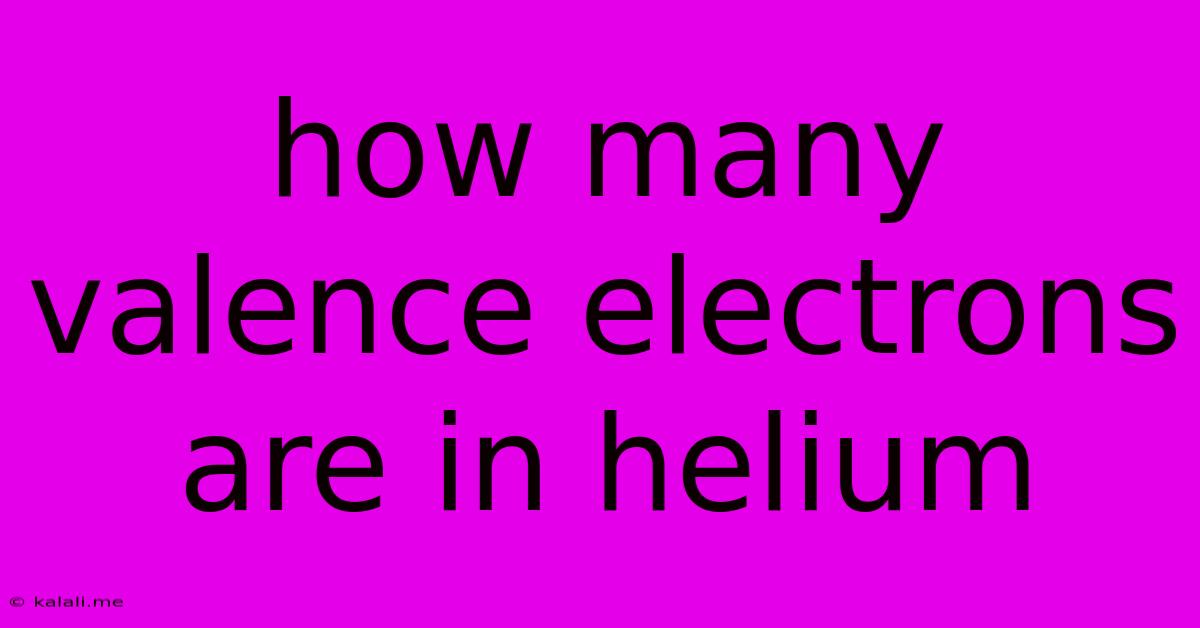How Many Valence Electrons Are In Helium
Kalali
Jun 05, 2025 · 2 min read

Table of Contents
How Many Valence Electrons Does Helium Have? Understanding Helium's Electronic Structure
Helium, the lightest noble gas, is renowned for its unique properties, including its inertness and low density. Understanding its electronic structure, particularly the number of valence electrons, is crucial to grasping its chemical behavior. This article will delve into the specifics of helium's valence electrons and explain why it's so unreactive.
Helium possesses two valence electrons. This seemingly simple fact is fundamental to its chemical stability and explains its lack of reactivity. Let's break down why.
Understanding Valence Electrons
Valence electrons are the electrons located in the outermost shell of an atom. These electrons are the ones involved in chemical bonding and determine an element's reactivity. Atoms strive to achieve a stable electron configuration, often by gaining, losing, or sharing valence electrons. For many atoms, this stable configuration is achieved by having a full outermost electron shell.
Helium's Electron Configuration
Helium's atomic number is 2, meaning it has two protons and two electrons. Its electron configuration is 1s², indicating that both electrons fill the first electron shell (the s subshell). Because the first electron shell can hold a maximum of two electrons, helium's outermost shell is completely filled. This full outermost shell is the reason why helium is exceptionally stable and unreactive.
Why Helium is Inert
The complete outermost electron shell makes helium extremely stable. It has no tendency to gain, lose, or share electrons to achieve a more stable configuration because it already possesses one. This inherent stability is why helium is classified as a noble gas and is chemically inert, meaning it doesn't readily form chemical bonds with other atoms.
Helium's Applications
Helium's unique properties, stemming directly from its electron configuration and inertness, lead to various applications. These include:
- Balloons and Airships: Helium's low density makes it ideal for inflating balloons and airships.
- Cryogenics: Helium's extremely low boiling point makes it useful in cryogenics, the science of very low temperatures.
- Welding: Helium's inertness protects the weld from oxidation.
- Medical Imaging: Helium is used in MRI machines.
Conclusion
In summary, helium has two valence electrons, a number that dictates its chemical behavior. This complete outermost electron shell results in exceptional stability and inertness, distinguishing it as a noble gas and leading to its diverse applications across various industries. Understanding helium's electronic structure provides valuable insight into its unique properties and importance.
Latest Posts
Latest Posts
-
How To Get Labels Off Wine Bottles
Jun 07, 2025
-
How To Remove Suit Jacket Lining
Jun 07, 2025
-
Is Taking A Drink To The Bathroom Kosher
Jun 07, 2025
-
Why Cant I Delete News App On Mac
Jun 07, 2025
-
Is It Immoral For Infertile To Have Sex Catholic
Jun 07, 2025
Related Post
Thank you for visiting our website which covers about How Many Valence Electrons Are In Helium . We hope the information provided has been useful to you. Feel free to contact us if you have any questions or need further assistance. See you next time and don't miss to bookmark.